
Aug '05 - Jan '11
What is an index? A quick reference? You idiot. A list of items and their locations? No, no, no. An index is evidence of a process. Now lets not get carried away. Evidence of a process does not guarantee indexicality. After all, any material construction can be said to be evidence of a process. It's there, right?
So what is indexical architecture? What qualities define it? What characteristics must it have to be considered indexical?
---
In other news... the parametric project turned out quite well, despite the fact that my model was an absolute failure. I spent a good amount of time developing my argument in my boards, which were received well. There was a vigorous discussion and I managed to steer the attention away from my model.
----
The Viennese students are gone. Don't know if I mentioned it before, but Knowlton is doing an exchange with the Vienna University of Applied Arts, where Zaha, Greg Lynn, and Wolf Prix conducts studios. About 15 of them came to visit and take part in various seminars, including a Rhinoscript workshop with Andrew Kudless. They cranked out some pretty interesting projects (high-rises) in the 10 days they were here. It was also great to get the nitty gritty on their superstar studio profs.
A group of students is going to Vienna in December to complete the exchange. Looking forward to hearing about it -- it's possible that the program will become a studio option next year for our class, which would be pretty sweet.
----
We've already installed three shows in the gallery and around the building. The first was called "Drawn by Hand" and celebrated masters of representation at OSU over the past 100 years... a lot of hand drawing tools, books, and drawings from our archives. 


We also made a tie to computer modeling, highlighting the history of projective geometry that is coded into 3d modelers like FormZ (developed by Christos Yessios of OSU fame). I sat next to Yessios at the luncheon. Nice guy.
Some 3d printed models from the show:
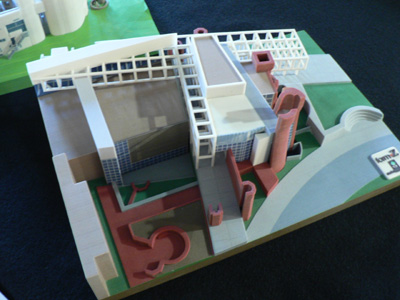
An interesting traveling show had its headquarters at Knowlton Hall at the top of the main stairs. It was called "Working Frameworks" and started at Cornell, stopped at Knowlton, and continued to Columbia in Chicago. The most prominent piece in our building was the "Control Room", which was designed and implemented by Gene Felice and company fromt he Art and Technology dpeartment at OSU. The podium was custom built and has wireless connectivity to the host site of the exhibition and displayed live webcam feeds as well as archival content from the previous opening of the show in Cornell. The content gathered in Columbus will be displayed in Chicago.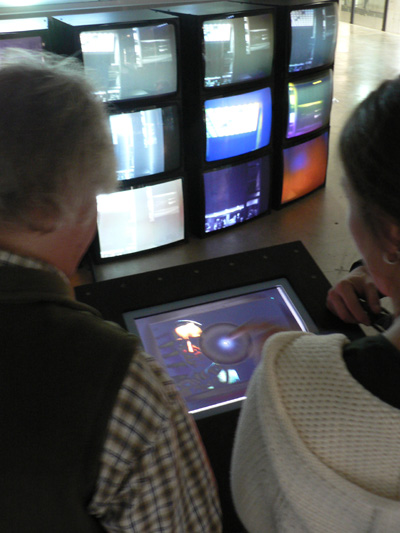
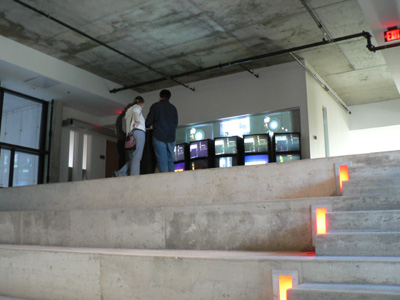
Finally, a new exhibit went up and opened in the gallery this Wednesday. Ben Aranda (who, with Chris Lasch, make up Terraswarm) came in for a lecture and to help set up the exhibit, a series of boards, books, models, and projections. I worked on the installation up until the very last minute, but it opened without a hitch and everybody was happy. Their drawings are quite beautiful and their books are pretty fascinating. I'll post pics in a bit.
In the meantime, a picture of my back yard, newly mowed and mulched, ready for a winter sleep: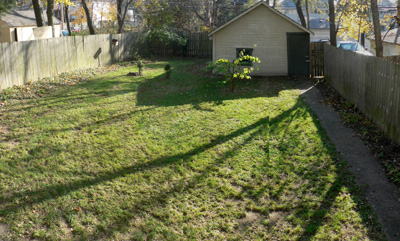



14 Comments
we were talking 'bout the indexical 12 years ago- somethings never change in the halls of the KSA...
Ha. Yup. 5 years ago as well.
Treekiller, garpike> maybe you can answer metamechanic's question then? I'd like to hear an answer to the question myself.
how 'bout a marking or registration of the steps in a process?
a drawing of attention to the passage of time,
the performance of specific tasks,
and the actions of the environment on the process, ...
...for example, among the myriad of things of which an architectural artifact could exhibit an index-ing.
doesn't have to be complicated. wouldn't a simple gnomon be an indexical architecture?
I don't know about that... wouldn't the *shadow* of the gnomon be the index? Thus the architecture is a generator of an index through its existence in relation to the process of the sun's movement.
Furthermore, if a gnomon is to be considered indexical architecture, what's to say that any building, when placed in the natural environment, is not also indexical architecture? And if this is the case, what is the use of the term that has so generalized of a meaning?
So my question is - what are the useful boundaries of the description of indexical architecture?
i want to stab the word "indexical" with a thousand knives.
i believe that's misdirected anger, chakroff... besides, if this is anything lilke your love affair with the words "deterritorialized" and "reterritorialized," you'll be using the word "indexical" as often as possible in 6 months.
i believe territorializing a landscape would improve its' indexability. not certain though.
... a deterritorialized indexical landscape looks a lot like my backyard. Most of the time, neglected, evidence of a process unclear...
i don't agree that the indexed has to be ON the architecture for it to be an indexical architecture. why can't the architecture be merely the implementation of index - if that's what the architecture is about?
which gets to your second point: yes, all architecture is an indexical architecture to a point. the difference is in the intention. a gnomon is about the making visible of the passage of time. my house, though it also casts a shadow (and stands as a good example of entropy) is not.
You asked, so here it is- the archibabble definitions:
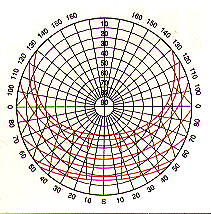
Index (verb) : to systematically expose (i.e. to map) latent traces of events, temporal phenomina, or other subtle systems embedded in a place or space via a diagram (can be 2d or 3d).
SW- a gnomon provides the shadow, but isn't a index- a sun chart on the other hand (the diagram produced by a gnomon) is a basic index of the sun's movements.
Indexical (adj) : To base a design process on a diagram of a place (i.e. an index). Example: if the project is a literal derivative of the diagram, then critics will use indexical as a negative (like extruding a 2d diagram to generate a buildings section or creating a building in the shape of a car) since this doesn't develop the ideas any further. Process is important in developing a successful index and project, the further the path of creativity goes, typically the better the response by the critics.
I agree... the sun chart is the index, and if fragments of the sunchart are represented in meaningful relation to the gnomon (as in the sundial), then the whole construction can be considered indexical.
It seems that the success or failure of an indexical architecture includes not only the quality of the index, but the degree to which one can achieve a reading of that index with a simple, refined vocabulary -- that is, one strives for subtlety and elegance and wants to avoid being ham-handed. For fear of being post-deconstructuralist?
But seriously, treekiller> If the concept of indexical architecture is passe, what is the cutting edge of academic architecture? Parametric design, emergent form, algorithmic design? It seems like these have all been around for 10 years or more as well, but it's all we hear about from the supposed top theoretical arch firms and academicians. So what is it? Are we floundering? Waiting for the next big thing?
I didn't say that indexing is passe- just that literal translation of an 'index/map' is typically subject to harsh criticism for lack of 'rigor'/effort. most 'cutting edge' practitioners have forgotten that sites exist. they just create crap inside the computer script - that is passe.
Some generative/algorythmic processes start with some sort of index of a site... so the act of creating an index is still very salient and the basis of good cutting edge work.
As a diagram and method of site analysis, there is no ideology or philosophy inherent with making an index per say. it is how the index/map is utilized in the refinement and later design process...
If you attempt to 'index' finnegans wake, you are engaging in an act of post-structural, aka pre-deconstructural dogma. But the act of indexing is tied to a site- so you can't index a text, that is just a diagram.
Block this user
Are you sure you want to block this user and hide all related comments throughout the site?
Archinect
This is your first comment on Archinect. Your comment will be visible once approved.